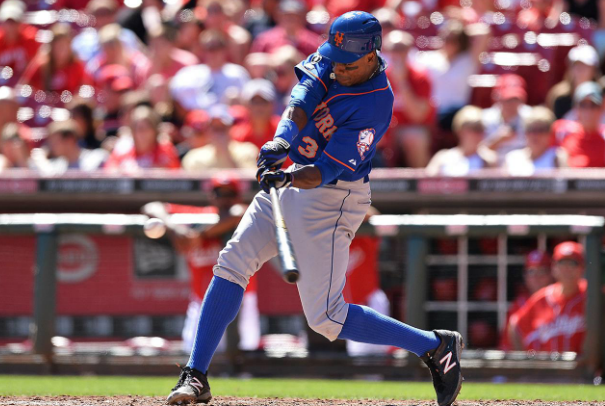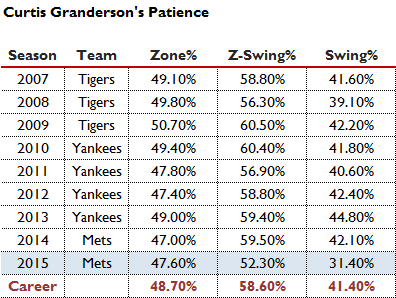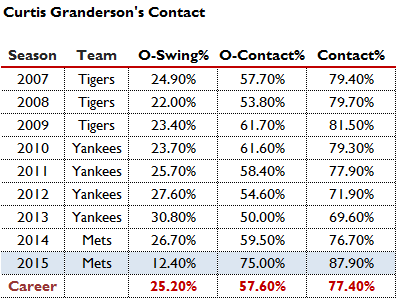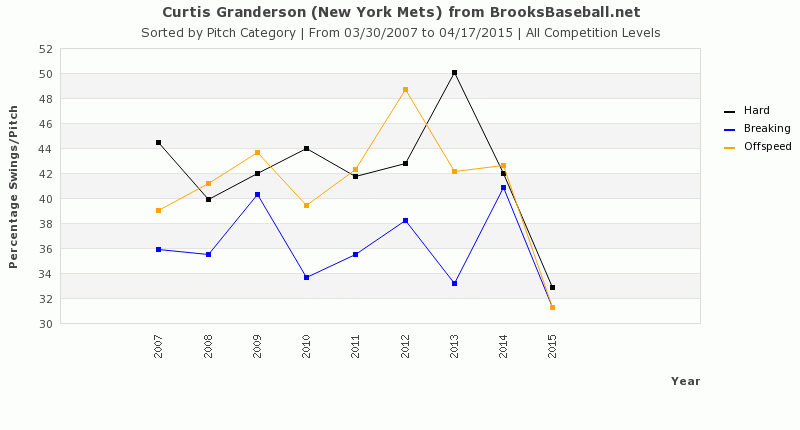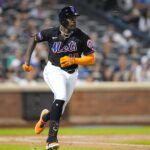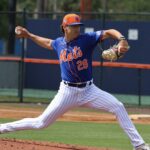It was the eighth inning of a tie game, Juan Jaime was on the mound for Atlanta, and Curtis Granderson drew a lead-off walk. He would then steal second, reach third on a bunt, before scoring the eventual winning run on a sacrifice fly hit by Daniel Murphy. Without recording a hit, Granderson had done what a lead-off hitter is supposed to do: he got on base, used his legs to advance, and later crossed the plate to score a key run.
 When the Mets started the season with a new-look lineup, batting Curtis Granderson lead-off seemed like a bad idea to me. The left-hander has the ability to get on base, yes, but he also produces power. It would be a waste to bat him in a lineup position where he sees the least number of men on base. Why waste his power? So, that was my logic.
When the Mets started the season with a new-look lineup, batting Curtis Granderson lead-off seemed like a bad idea to me. The left-hander has the ability to get on base, yes, but he also produces power. It would be a waste to bat him in a lineup position where he sees the least number of men on base. Why waste his power? So, that was my logic.
Through a very small sample of games, Granderson has been an on-base machine, this, despite hitting the ball very little. He has reached base in nine of the Mets’ ten games played, while only hitting 5-30 in that span.
What Granderson is doing to reach base so frequently is drawing walks. His 26.8% BB rate leads the major leagues. A power-hitter with a tendency to strike out a lot, Grandy has nearly cut his career whiff percentage in half, his at-bats ending in K’s only 12.2% of the time.
The Mets want a lead-off hitter who can get on-base, and Granderson is doing that with a more patient approach at the plate.
But is that a good thing?
Sabermetricians will tell you that a walk is as good as a hit. It makes sense. Whether you reach first base via a free pass or a hard hit grounder, it doesn’t matter, as long as you are standing on first at the end of the at-bat.
While a walk is as good as a single, we shouldn’t forget that a walk is not as good as other things, such as a double, triple, or home run.
If Curtis Granderson changes the way he approaches at-bats, being more patient, so he can draw walks, are the Mets losing something? Are they losing his power? Is it better to have a walking Granderson than a swing-for-the-fences type?
Let’s take a look at how Granderson has become more patient at the plate over the first ten games this season.
One could suggest that Granderson is drawing more walks because he is seeing less strikes. Not true. He is seeing just as many pitches in the strike zone this season as he did last season, and right around the average number he has seen throughout his career. The difference is not in how many pitches he sees in the zone, but how often he swings at them. His 52.3% swing rate at strikes, lower than his traditional swing rate, and when you consider his overall swing rate, which includes at pitches both inside and outside the strike zone, he is lifting the bat off his shoulder about 25% less than typical for his career.
It is on pitches outside of the strike zone, where Granderson has found the most patience. His O-Swing% a miniscule 12.4%, and on the few bad pitches that he does offer at, he is making contact on them, an incredible 75% of the time, which has helped boost his overall contact rate to 87.9%.
Everything makes sense so far. Granderson is swinging less, making contact more, and as a result, his OBP has ballooned to .390, with a BB – K rate of 14.6 %.
While getting on base is an honorable thing, as we mentioned earlier, a walk is only as good as a single. As a less aggressive hitter, Granderson may be sacrificing added production. As of Friday, his batting average has shrunk to .167, identical to his slugging percentage, as he has yet to get an extra base hit this season.
Throughout his career, Grandy has feasted on fastballs for power. Since 2007, nearly two-thirds of his home runs have come on four-seam and two-seam fastballs. In that time, having seen over 10,000 pitches between the two fastball types, he has slugged .542 against four-seamers and .547 against sinkers. This season, not so much. He has five hits on the season, all singles.
We can see from the graph below that perhaps Granderson’s issue is not just in result, but in the lack of opportunity he is giving himself to crush hard-thrown pitches. While he is swinging less at everything, the pitches he sees the most, and has been very aggressive against in the past, four-seams and sinkers, he is letting go past him.
Curtis Granderson is drawing a lot of walks. He is doing so because he is making more contact on pitches, especially out of the zone, fouling them off to work a deeper count, but more so, he has been extremely selective at the pitches he swings at, even the ones in the strike zone. By letting more fastballs fly past him, he may force the pitcher to mix in more pitches, such as change-ups and sliders, both resulting in more called balls, but he is also passing on the opportunity to hit the type of pitches that he traditionally hits the hardest.
It’s worth celebrating Granderson’s .390 on-base percentage despite him slumping through the first ten games of the season. But hopefully, looking at how selective he has been at the plate, the lost power in exchange for walks is not a long-term outcome. It would help Granderson to be a little more selective, but he needs to find the right balance to be most productive for the Mets.
Statistics courtesy of FanGraphs and Brooks Baseball. Follow me on Twitter @OverWhitestone.

